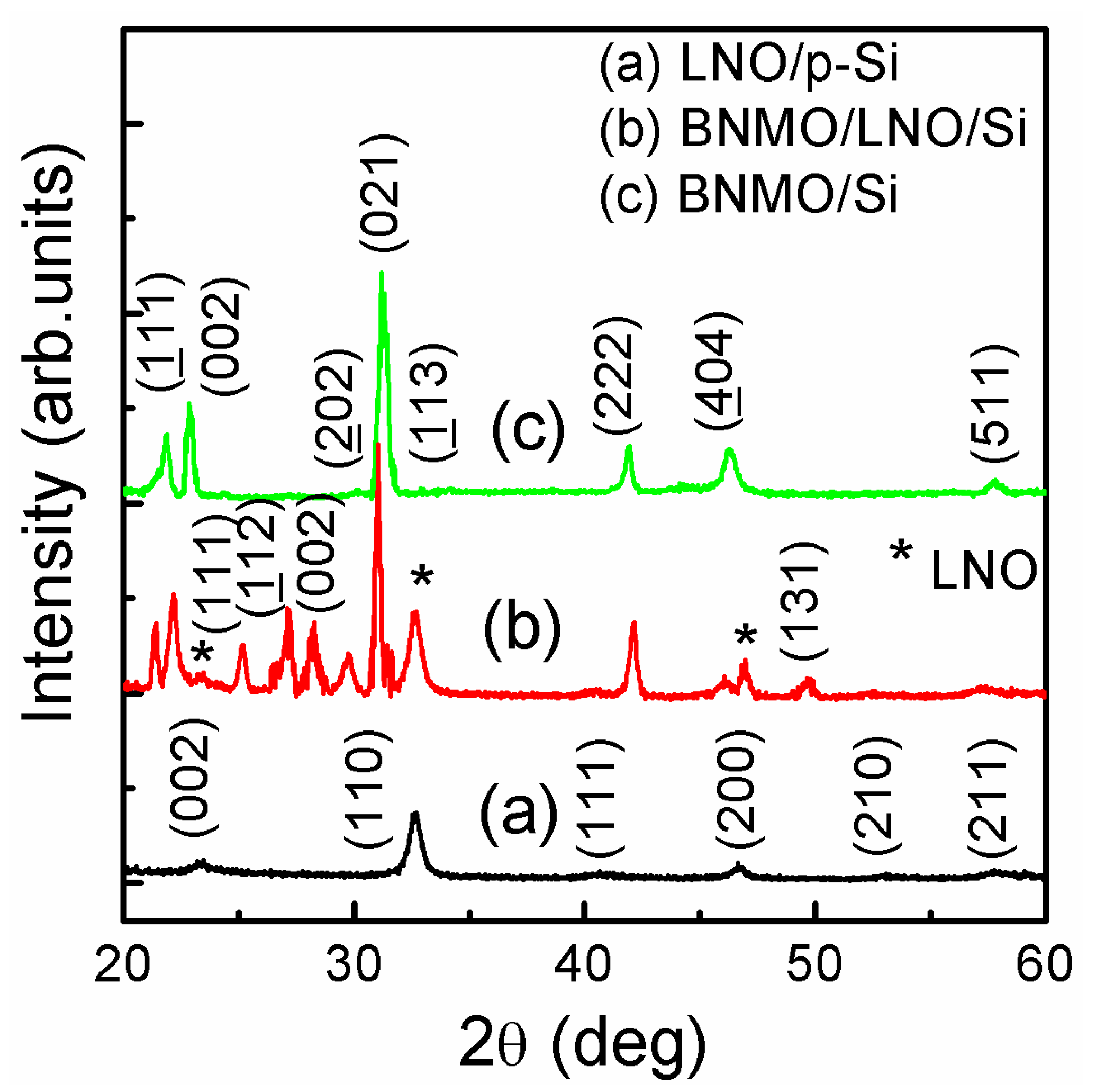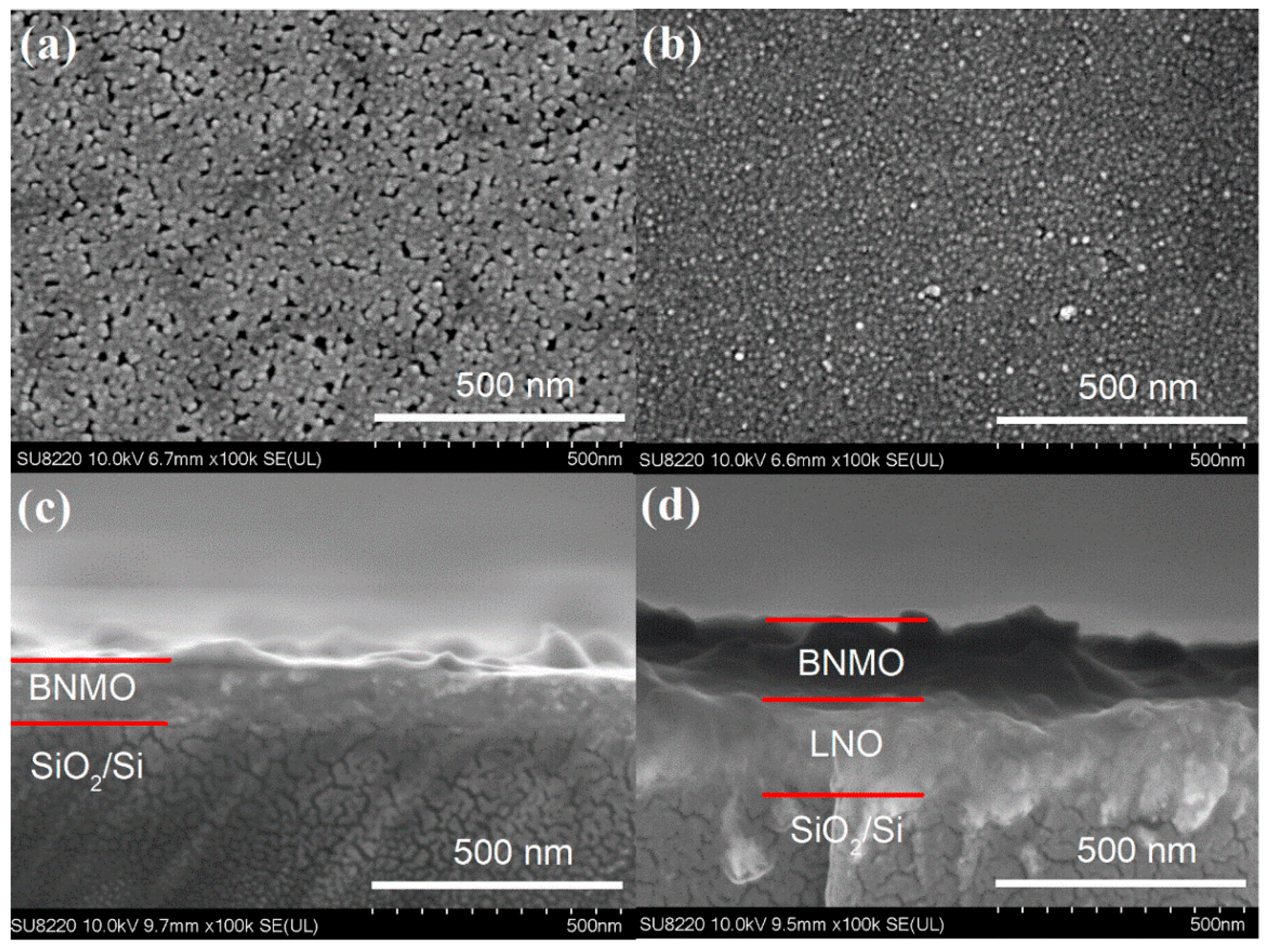Ferroelectric Diode Effect with Temperature Stability of Double Perovskite Bi2NiMnO6 Thin Films
Abstract
1. Introduction
2. Materials and Methods
3. Results and Discussion
4. Conclusions
Author Contributions
Funding
Conflicts of Interest
References
- Park, S.; Lee, B.; Bae, B.; Chai, J.; Lee, S.; Kim, C. Ambipolar thin-film transistors based on organic semiconductor blend. Synth. Met. 2019, 253, 40–47. [Google Scholar] [CrossRef]
- Shiryaev, A.O.; Rozanov, K.N.; Vyzulin, S.A.; Kevraletin, A.L.; Syr’ev, N.E.; Vyzulin, E.S.; Lahderanta, E.; Maklakov, S.A.; Granovsky, A.B. Magnetic resonances and microwave permeability in thin Fe films on flexible polymer substrates. J. Magn. Magn. Mater. 2018, 461, 76–81. [Google Scholar] [CrossRef]
- Makhlouf, M.M. Preparation and optical characterization of β-MnO2 nano thin films for application in heterojunction photodiodes. Sens. Actuators A Phys. 2018, 279, 145–156. [Google Scholar] [CrossRef]
- Munshi, A.H.; Sasidharan, N.; Pinkayan, S.; Barth, K.L.; Sampath, W.S.; Ongsakul, W. Thin-film CdTe photovoltaics—The technology for utility scale sustainable energy generation. Sol. Energy 2018, 173, 511–516. [Google Scholar] [CrossRef]
- Yin, L.; Wang, C.; Li, L.; Shen, Q.; Zhang, L. Large room temperature magnetoresistance in La0.9Sr0.1MnO3 thin films. J. Alloys Compd. 2018, 730, 327–332. [Google Scholar] [CrossRef]
- Mitta, S.B.; Reddeppa, M.; Vellampatti, S.; Dugasani, S.R.; Yoo, S.; Lee, S.; Kim, M.D.; Park, S.H. Gold nanoparticle-embedded DNA thin films for ultraviolet photodetectors. Sens. Actuators B Chem. 2018, 275, 137–144. [Google Scholar] [CrossRef]
- Azuma, M.; Takata, K.; Saito, T.; Ishiwata, S.; Shimakawa, Y.; Takano, M. Designed Ferromagnetic, Ferroelectric Bi2NiMnO6. J. Am. Chem. Soc. 2005, 127, 8889–8892. [Google Scholar] [CrossRef]
- Sakai, M.; Masuno, A.; Kan, D.; Hashisaka, M.; Takata, K.; Azuma, M.; Takano, M.; Shimakawa, Y. Multiferroic thin film of Bi2NiMnO6 with ordered double-perovskite structure. Appl. Phys. Lett. 2007, 90, 072903. [Google Scholar] [CrossRef]
- Iliev, M.N.; Padhan, P.; Gupta, A. Temperature-dependent Raman study of multiferroic Bi2NiMnO6 thin films. Phys. Rev. B 2008, 77, 172303. [Google Scholar] [CrossRef]
- Padhan, P.; LeClair, P.; Gupta, A.; Srinivasan, G. Magnetodielectric response in epitaxial thin films of multiferroic Bi2NiMnO6. J. Phys. Condens. Matter 2008, 20, 355003. [Google Scholar] [CrossRef]
- Padhan, P.; LeClair, P.; Gupta, A.; Subramanian, M.A.; Srinivasan, G. Magnetodielectric effect in Bi2NiMnO6-La2NiMnO6 superlattices. J. Phys. Condens. Matter 2009, 21, 306004. [Google Scholar] [CrossRef] [PubMed]
- Rathi, A.; Anshul, A.; Gupta, A.; Rout, P.K.; Maurya, K.K.; Kotnala, R.K.; Pant, R.P.; Basheed, G.A. Large low-field magnetodielectric response in multiferroic Bi2NiMnO6 thin film. J. Phys. D Appl. Phys. 2017, 50, 135006. [Google Scholar] [CrossRef]
- Zhao, H.J.; Chen, X.M. First-principles study on the differences of possible ferroelectric behavior and magnetic exchange interaction between Bi2NiMnO6 and La2NiMnO6. AIP Adv. 2012, 2, 042143. [Google Scholar] [CrossRef]
- Ciucivara, A.; Sahu, B.; Kleinman, L. Density functional study of multiferroic Bi2NiMnO6. Phys. Rev. B 2007, 76, 064412. [Google Scholar] [CrossRef]
- Shimakawa, Y.; Kan, D.; Kawai, M.; Sakai, M.; Inoue, S.; Azuma, M.; Kimura, S.; Sakata, O. Direct observation of B-site ordering in multiferroic Bi2NiMnO6 thin film. Jpn. J. Appl. Phys. 2007, 46, L845–L847. [Google Scholar] [CrossRef]
- Bahoosh, S.G.; Wesselinowa, J.M.; Trimper, S. The magnetoelectric effect and double-perovskite structure. Phys. Status Solidi B 2012, 249, 1602–1606. [Google Scholar] [CrossRef]
- Zhao, H.J.; Liu, X.Q.; Chen, X.M. Density functional investigations on electronic structures, magnetic ordering and ferroelectric phase transition in multiferroic Bi2NiMnO6. AIP Adv. 2012, 2, 022115. [Google Scholar] [CrossRef]
- Dieguez, D.; Iniguez, J. Multiferroic Bi2NiMnO6 thin films: A computational prediction. Phys. Rev. B 2017, 95, 085129. [Google Scholar] [CrossRef]
- Li, W.P.; Liu, Q.X.; Tang, X.G.; Lai, J.L.; Jiang, Y.P. Low leakage current in (Bi0.95La0.05)2NiMnO6 double-perovskite thin films prepared by chemical solution deposition. Mater Lett. 2014, 120, 23–25. [Google Scholar] [CrossRef]
- Harijan, P.K.; Singh, A.; Upadhyay, C.; Pandey, D. Néel transition in the multiferroic BiFeO3-0.25PbTiO3 nanoparticles with anomalous size effect. J. Appl. Phys. 2019, 125, 024102. [Google Scholar] [CrossRef]
- Cerrato, J.M.; Hochella, M.F.; Knocke, W.R.; Dietrich, A.M.; Cromer, T.F. Use of XPS to Identify the Oxidation State of Mn in Solid Surfaces of Filtration Media Oxide Samples from Drinking Water Treatment Plants. Environ. Sci. Technol. 2010, 44, 5881–5886. [Google Scholar] [CrossRef] [PubMed]
- Amaya, Á.A.; González, C.A.; Niño-Gómez, M.E.; Martínez, O.F. XPS fitting model proposed to the study of Ni and La in deactivated FCC catalysts. J. Electron. Spectrosc. 2019, 233, 5–10. [Google Scholar] [CrossRef]
- Afroz, K.; Moniruddin, M.; Bakranov, N.; Kudaibergenov, S.; Nuraje, N.A. Heterojunction strategy to improve the visible light sensitive water splitting performance of photocatalytic materials. J. Mater. Chem. A 2018, 6, 21696–21718. [Google Scholar] [CrossRef]
- Chang, C.M.; Hsu, C.H.; Liu, Y.W.; Chien, T.C.; Sung, C.H.; Yeh, P.H. Interface engineering: Broadband light and low temperature gas detection abilities using a nano-heterojunction device. Nanoscale 2015, 7, 20126–20131. [Google Scholar] [CrossRef] [PubMed]
- Kumar, S.G.; Rao, K.S.R.K. Physics and chemistry of CdTe/CdS thin film heterojunction photovoltaic devices: Fundamental and critical aspects. Energy Environ. Sci. 2014, 7, 45–102. [Google Scholar] [CrossRef]
- Dietz, G.W.; Waser, R. Charge injection in SrTiO3 thin films. Thin Solid Film. 1997, 299, 53–58. [Google Scholar] [CrossRef]
- Wang, Y.G.; Tang, X.G.; Liu, Q.X.; Jiang, Y.P.; Jiang, L.L. Room temperature tunable multiferroic properties in sol-gel derived nanocrystalline Sr(Ti1−xFex)O3−δ thin films grown on LaNiO3 buffered silicon substrates. Nanomaterials 2017, 7, 264. [Google Scholar] [CrossRef]
- Barnett, C.J.; Mourgelas, V.; McGettrick, J.D.; Maffeis, T.G.G.; Barron, A.R.; Cobley, R.J. The effects of vacuum annealing on the conduction characteristics of ZnO nanorods. Mater. Lett. 2019, 243, 144–147. [Google Scholar] [CrossRef]
- Lee, H.S. Electrokinetic analyses in biofilm anodes: Ohmic conduction of extracellular electron transfer. Bioresour. Technol. 2018, 256, 509–514. [Google Scholar] [CrossRef]
- Abbaszadeh, D.; Blom, P.W.M. Efficient Blue Polymer Light-Emitting Diodes with Electron-Dominated Transport Due to Trap Dilution. Adv. Electron. Mater. 2016, 2, 1500406. [Google Scholar] [CrossRef]
- Rani, V.; Sharma, A.; Kumar, P.; Singh, B.; Ghosh, S. Charge transport mechanism in copper phthalocyanine thin films with and without traps. RSC Adv. 2017, 7, 54911–54919. [Google Scholar] [CrossRef]
- Shah, S.S.; Hayat, K.; Ali, S.; Rasool, K.; Iqbal, Y. Conduction mechanisms in lanthanum manganite nanofibers. Mat. Sci. Semicon. Proc. 2019, 90, 65–71. [Google Scholar] [CrossRef]
- Perello, D.J.; Lim, S.C.; Chae, S.J.; Lee, I.; Kim, M.J.; Lee, Y.H.; Yun, M. Thermionic Field Emission Transport in Carbon Nanotube Transistors. ACS Nano 2011, 5, 1756–1760. [Google Scholar] [CrossRef] [PubMed]
- Rodriguez-Nieva, J.F.; Dresselhaus, M.S.; Levitov, L.S. Thermionic Emission and Negative dI/dV in Photoactive Graphene Heterostructures. Nano Lett. 2015, 15, 1451–1456. [Google Scholar] [CrossRef]
- Chen, C.C.; Aykol, M.; Chang, C.C.; Levi, A.F.J.; Cronin, S.B. Graphene-Silicon Schottky Diodes. Nano Lett. 2011, 11, 1863–1867. [Google Scholar] [CrossRef]
- Lao, C.S.; Liu, J.; Gao, P.; Zhang, L.; Davidovic, D.; Tummala, R.; Wang, Z.L. ZnO Nanobelt/Nanowire Schottky Diodes Formed by Dielectrophoresis Alignment across Au Electrodes. Nano Lett. 2006, 6, 263–266. [Google Scholar] [CrossRef]






© 2019 by the authors. Licensee MDPI, Basel, Switzerland. This article is an open access article distributed under the terms and conditions of the Creative Commons Attribution (CC BY) license (http://creativecommons.org/licenses/by/4.0/).
Share and Cite
Zhong, W.-M.; Liu, Q.-X.; Tang, X.-G.; Jiang, Y.-P.; Li, W.-H.; Li, W.-P.; Cheng, T.-D. Ferroelectric Diode Effect with Temperature Stability of Double Perovskite Bi2NiMnO6 Thin Films. Nanomaterials 2019, 9, 1783. https://doi.org/10.3390/nano9121783
Zhong W-M, Liu Q-X, Tang X-G, Jiang Y-P, Li W-H, Li W-P, Cheng T-D. Ferroelectric Diode Effect with Temperature Stability of Double Perovskite Bi2NiMnO6 Thin Films. Nanomaterials. 2019; 9(12):1783. https://doi.org/10.3390/nano9121783
Chicago/Turabian StyleZhong, Wen-Min, Qiu-Xiang Liu, Xin-Gui Tang, Yan-Ping Jiang, Wen-Hua Li, Wan-Peng Li, and Tie-Dong Cheng. 2019. "Ferroelectric Diode Effect with Temperature Stability of Double Perovskite Bi2NiMnO6 Thin Films" Nanomaterials 9, no. 12: 1783. https://doi.org/10.3390/nano9121783
APA StyleZhong, W.-M., Liu, Q.-X., Tang, X.-G., Jiang, Y.-P., Li, W.-H., Li, W.-P., & Cheng, T.-D. (2019). Ferroelectric Diode Effect with Temperature Stability of Double Perovskite Bi2NiMnO6 Thin Films. Nanomaterials, 9(12), 1783. https://doi.org/10.3390/nano9121783




